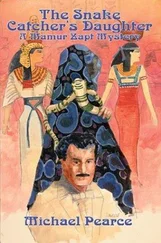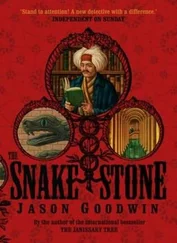John Godey - The Snake
Здесь есть возможность читать онлайн «John Godey - The Snake» весь текст электронной книги совершенно бесплатно (целиком полную версию без сокращений). В некоторых случаях можно слушать аудио, скачать через торрент в формате fb2 и присутствует краткое содержание. Жанр: Ужасы и Мистика, Триллер, на английском языке. Описание произведения, (предисловие) а так же отзывы посетителей доступны на портале библиотеки ЛибКат.
- Название:The Snake
- Автор:
- Жанр:
- Год:неизвестен
- ISBN:нет данных
- Рейтинг книги:3 / 5. Голосов: 1
-
Избранное:Добавить в избранное
- Отзывы:
-
Ваша оценка:
- 60
- 1
- 2
- 3
- 4
- 5
The Snake: краткое содержание, описание и аннотация
Предлагаем к чтению аннотацию, описание, краткое содержание или предисловие (зависит от того, что написал сам автор книги «The Snake»). Если вы не нашли необходимую информацию о книге — напишите в комментариях, мы постараемся отыскать её.
The Snake — читать онлайн бесплатно полную книгу (весь текст) целиком
Ниже представлен текст книги, разбитый по страницам. Система сохранения места последней прочитанной страницы, позволяет с удобством читать онлайн бесплатно книгу «The Snake», без необходимости каждый раз заново искать на чём Вы остановились. Поставьте закладку, и сможете в любой момент перейти на страницу, на которой закончили чтение.
Интервал:
Закладка:
Sweden: as recently as sixteenth century, Swedes worshipped snakes as household gods, and snakes not to be killed under any circumstances.
Notion later spread to other European countries.
Ancient Greece: snake regarded as healer. Vide Aesculapius, god of Greek medicine. Caduceus, staff wreathed with two snakes, carried by Hermes, and still familiar emblem of physicians and medicine. Go fight the AMA, Reverend!
But Reverend has his innings with coming of Christianity, where snake firmly established as symbol of evil. Christians opposed idea of snake worship (one God, right?), so fingered it as epitome of evil. Snake's big caper: tricked Adam and Eve into original sin and expulsion from Eden.
Said God: "Henceforth be enmity between serpent and man," and turned it into a belly-crawler. Church put shoulder to wheel, selling idea of snake as symbol of evil. Put it across, too-credit where credit due. Medieval artists (dependent on church for patronage) used snake as symbol of evil.
In old drawings, Devil's penis snakelike, sinuous, sometimes forked, resembling snake's tongue. Sounds interesting.
Modern times: in Abruzzi region of Italy, snake-handling feature of religious festival taking place every May; in church in Kentucky, twenty-five years ago, handling of snakes-diamondback and timber rattlers-used to be regular occurrence. Hopis (see above) do snake dance in Arizona, priests take heads in mouth. Ugh!
Fact: although people die of snakebite (most in Asia, Australia, Africa, fewest in Europe, U.S.A.), number comparatively small. As M. Converse (what, again?) said, many more humans poison snakes than other way around. Most common-sprays used to kill insects, insects swallowed by snakes, accumulate in liver, liver swells until snake dies painful death.
No snakes eat humans, but humans eat snakes. Large constrictors most sought-after delicacy. Australian aborigines eat practically anything that crawls, but not poisonous ones. But Japanese eat sea snakes, which are poisonous. In Hong Kong, discerning diners eat poison kraits and cobras. U.S.A.-rattlers on menus used to be known as prairie eel."
Theories on why people hale snakes: they prefer upright animals, reflecting own image. Bears, cats, dogs, penguins, all get up on hind legs. Same sense, people like expressiveness in animals, particularly dogs, unlike snakes, which are stony-eyed because have no way of closing eyes. Probably not poisonousness of snakes that fills humans with revulsion so much as stitheriness. Also, they're sneaky-hard to see, vide snake in grass. But children two and three years old like to play with snakes. Around four, though, begin to develop aversion. Proves no innate fear of snakes, but instead brainwashing by parents?
Snakes as medicine: snakeskin’s used to cure everything from lumbago to hot flashes. In U.S., in more innocent times, hustlers sold "snake oil" as panacea. Years ago, Italian ladies would eat vipers to make complexion smooth. What price beauty! Hippocrates devised pessary of snake's fat and bull's fat. Pliny (the Elder, the Younger, who cares?) prescribed snake fat to cure baldness. Central American Indians drank rattlesnake venom as aphrodisiac. In some American Indian tribes, pregnant women ate powdered rattlesnake to shorten labour, as follows: child in womb hears rattle and hurries to get born, figuring snake is coming after him if he doesn't get out. Contradiction here, suggesting fear of snakes is prenatal? No. It's adult assigning own fears to unborn child.
Tidbits: man in California (where else?) committed suicide by jumping into rattlesnake pit. Hannibal supposed to have catapulted pots of snakes into Roman ships, causing panic. American Indians used to shoot at U.S. Cavalry with arrows dipped in snake venom. Didn't work.
Talk to editor about using some of this stuff as shirttail piece to Reverend story? Remember bits and pieces to show M. Converse how terrifically knowledgeable I am?
The snake cornered a rat near the retaining wall along Central Park West, but the surprise was not complete. The rat heard the slight sound of the snake's movement, and, before the snake could strike, ran away along the base of the wall. Where the wall broke for an opening to the street the rat stopped and turned and saw that the snake was pursuing it. It ran again, rounding the wall into the 4 A.M. stillness of Central Park West.
It paused briefly at the curb, its fur tingling from green to red with the change of a traffic light. When the snake slid around the wall onto the pavement the rat fled across the street.
Halfway up the street the rat tired, and the snake gained on it. The rat darted suddenly ~o its left, scampered behind a brownstone stoop, and hopped through the bars in front of an open window leading into a basement apartment.
The snake crawled past the stoop to the window. It inserted its head and neck through the bars, sinuous, swaying, then slid forward onto a table standing against the wall beneath the window. Without stopping, without waiting for its posterior to clear the bars, it began to wind down the table leg to the floor.
It paused, with its long wet tongue flicking, then glided through an open doorway into another room. It paused again, and now its flicking tongue tasted other doors than those of the rat.
Webster McPeek would never truly know whether he heard the snake or was simply awakened by some atavistic instinct. He sat upright in bed, and saw the snake almost at once and very clearly, in a fling of light from the streetlamp outside. Its head was up, its tongue was darting in and out.
McPeek shouted, loud and hoarse, his voice clogged by fear. His wife awoke in panic, and, when she saw the snake, screamed. The snake started to curl its long slender body into forward motion, and when McPeek realized that it was heading toward the children's bedroom he leaped out of bed, and ran after it toward the open door.
But the children, aroused by the shouting and screaming, were out of bed, and they appeared wide-eyed and frightened in the doorway. The snake was between McPeek and the children. He tried to wave them back into their room, but instead they ran toward him, arms outstretched, and the snake's head leaped forward and the children screamed. He ran toward them blindly, with his wife just behind him.
In the darkness, the snake struck out in a panic at the threshing legs, the stamping feet that threatened it. It struck several times, until the feet and legs retreated, and then it turned in a tight arc and glided swiftly back the way it had come, its head still high, its mouth open. It didn't pause, but pushed itself toward the table. It wound up the leg in a continuous motion, and slid through the bars over the window.
The snake ran down the street toward the park. But when it started to cross, a brightness bore down on it, moving very quickly, intensifying as it came closer. Pressing down hard with its scutes, throwing its body into powerful curves, the snake produced a surge of speed that carried it safely past the huge oncoming brightness. It ran along the base of the retaining wall until it found the opening it had come through in pursuit of the rat.
In the park, it slid off the pavement into the concealment of grass and brush.
Hyman Closs, cruising north on Central Park West after dropping a fare at 96th and Amsterdam, spotted the snake when he was a block away from it. At first he didn't believe it was real; it was one of those crazy fakes that were all over town. But when it slid down off the curb he knew it was no fake, it was the snake. He slammed his foot down on the accelerator and bore down on it. He braced himself queasily for the impact of his wheels bumping over it, but to his astonishment it outran him, and crawled up onto the sidewalk.
He braked, and looked behind him. It was gone. The speed of it! Tingling with excitement, he made a U-turn and headed downtown. He considered stopping at a phone booth, but he didn't want to get out on the street at 4:30 in the morning, so he decided to go to the precinct in the 85th Street transverse.
Читать дальшеИнтервал:
Закладка:
Похожие книги на «The Snake»
Представляем Вашему вниманию похожие книги на «The Snake» списком для выбора. Мы отобрали схожую по названию и смыслу литературу в надежде предоставить читателям больше вариантов отыскать новые, интересные, ещё непрочитанные произведения.
Обсуждение, отзывы о книге «The Snake» и просто собственные мнения читателей. Оставьте ваши комментарии, напишите, что Вы думаете о произведении, его смысле или главных героях. Укажите что конкретно понравилось, а что нет, и почему Вы так считаете.












